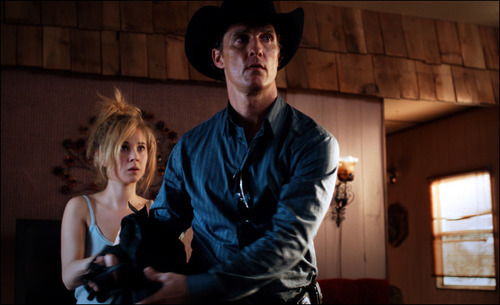Killer Joe (William Friedkin, 2012): USA
Review by Jian Gedrick.
 Killer Joe is a 2012 adaption of the controversial Tracy Letts play of the same name and doesn’t live up to its reputation of being disturbing, nor well-made, nor deserving of it’s NC-17 rating. As Letts wrote the screenplay, the film is very faithful to the original story. Young drug dealer Chris (Emile Hirsch) finds himself in deep trouble when his mother steals his stash and drug money, now needing to pay his crime boss back or it’s his life he hires psychopathic cop/hit man Joe Cooper (Matthew McConaughey) to kill her so he can collect the insurance money. Being short on payment for Joe, Chris prostitutes his mentally unstable sister Dottie (Juno Temple) as compensation. Naturally, the plan falls apart ending in a climax of brutality and gunfire. Shocking as this may sound, the film presents itself as a black comedy.
Killer Joe is a 2012 adaption of the controversial Tracy Letts play of the same name and doesn’t live up to its reputation of being disturbing, nor well-made, nor deserving of it’s NC-17 rating. As Letts wrote the screenplay, the film is very faithful to the original story. Young drug dealer Chris (Emile Hirsch) finds himself in deep trouble when his mother steals his stash and drug money, now needing to pay his crime boss back or it’s his life he hires psychopathic cop/hit man Joe Cooper (Matthew McConaughey) to kill her so he can collect the insurance money. Being short on payment for Joe, Chris prostitutes his mentally unstable sister Dottie (Juno Temple) as compensation. Naturally, the plan falls apart ending in a climax of brutality and gunfire. Shocking as this may sound, the film presents itself as a black comedy.
In fact, the outline of the story is the only shocking aspect to Killer Joe as it’s carried out with frustrating ineptitude and amateurism. Friedkin reportedly would only shoot a maximum of two takes for most scenes and the movie seems to suffer the consequences of these decisions, making Killer Joe feel more like an unrehearsed play than a bona fide film. There are several drawn-out scenes where the actors engage in long-winded, unintelligible dialogue while appearing to have no consensus on the scene’s tone, making their interactions feel very clunky and unnatural. This lack of organic chemistry is further weakened by Emile Hirsch’s dreadful performance. Juno Temple does stand out with a very nice performance as Dottie and Haden Church is likable as the hopelessly dumb father, but they still can’t save the film. The cinematography looks sloppy as though a film student was messing around with the focus, aperture, and color filter (shots are either overly bright, heavily saturated, or super fuzzy, sometimes all out once) giving the movie a low-rent quality, which is only worsened by the choreography.
The film has been noted for its intense violence, yet the violence is embarrassingly unconvincing and cheesy. There is a scene where Hirsch’s character gets beaten up by two thug bikers and reacts to a kick to the face that visibly misses him by a foot. A close up of his face covered in corn syrup is then shown as the beating continues and reveals even more clearly they aren’t making any contact, and at one point Hirsch has a delayed response to one of the strikes. Another example of the cheap violence occurs during the climax where Joe, in a psychotic rage, mercilessly pulverizes Chris’s face with a can of pumpkin only for Chris to have a perfectly-shaped face afterwards with fake blood brushed over it. No swelling, no disfigurement, nor any kind of sign to accurately indicate the trauma of such a savage beating, just a few simple fake blood brushes over the face. Killer Joe was given an NC-17 for two scenes: the phony tin can beating, and because a woman is forced to fellate a chicken leg held near a man’s crotch (an image that has been done over and over in a lot of movies).
To give films like this an NC-17 rating while giving more extreme films (Hostel 2, Bruno, etc.) an R is totally random and exemplifies the MPAA’s futility. High school-age viewers under 18 will be more likely to yawn at the film’s lame violent effects and smirk at the film’s silly poultry scene. Killer Joe amounts to being a killer joke due to a pitiful attempt of adapting a provocative play into a successful picture. Viewers should just skip it and watch Friedkin’s The Exorcist instead; it is everything Killer Joe isn’t.
1.5/4
About this entry
You’re currently reading “Killer Joe (William Friedkin, 2012): USA,” an entry on Student Film Reviews
- Published:
- 09.13.16 / 6am
- Category:
- Films
7 Comments
Jump to comment form | comments rss [?]